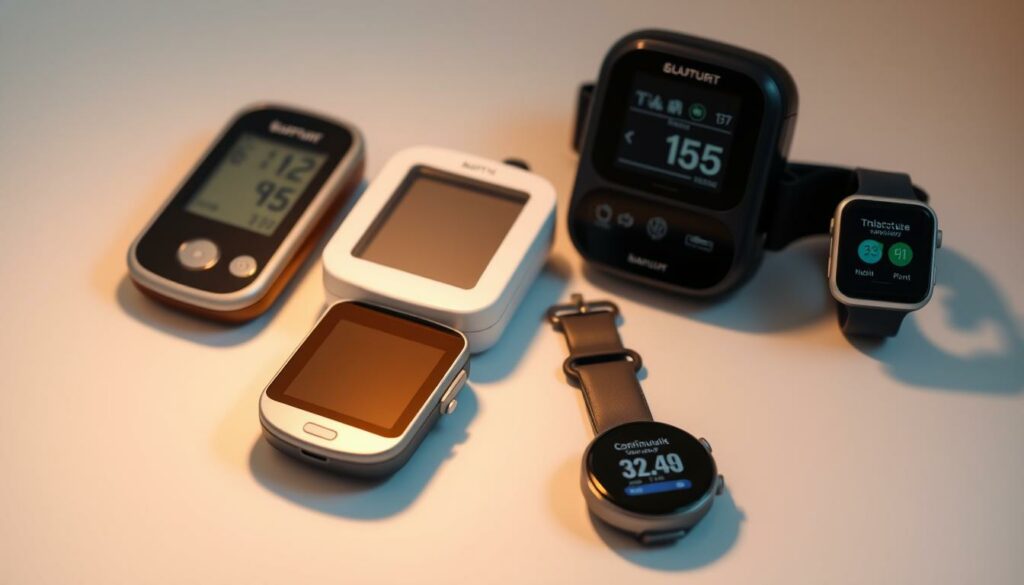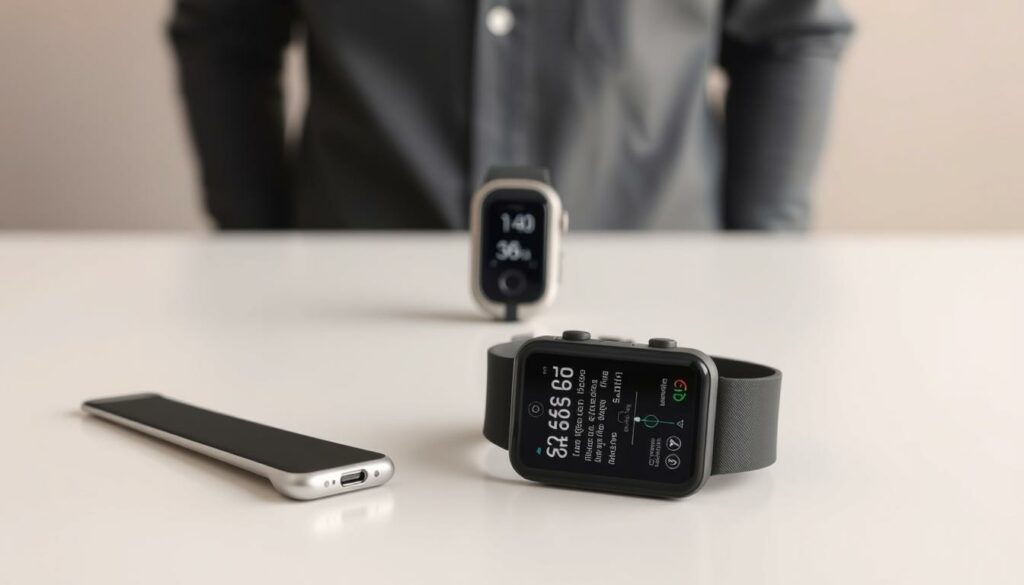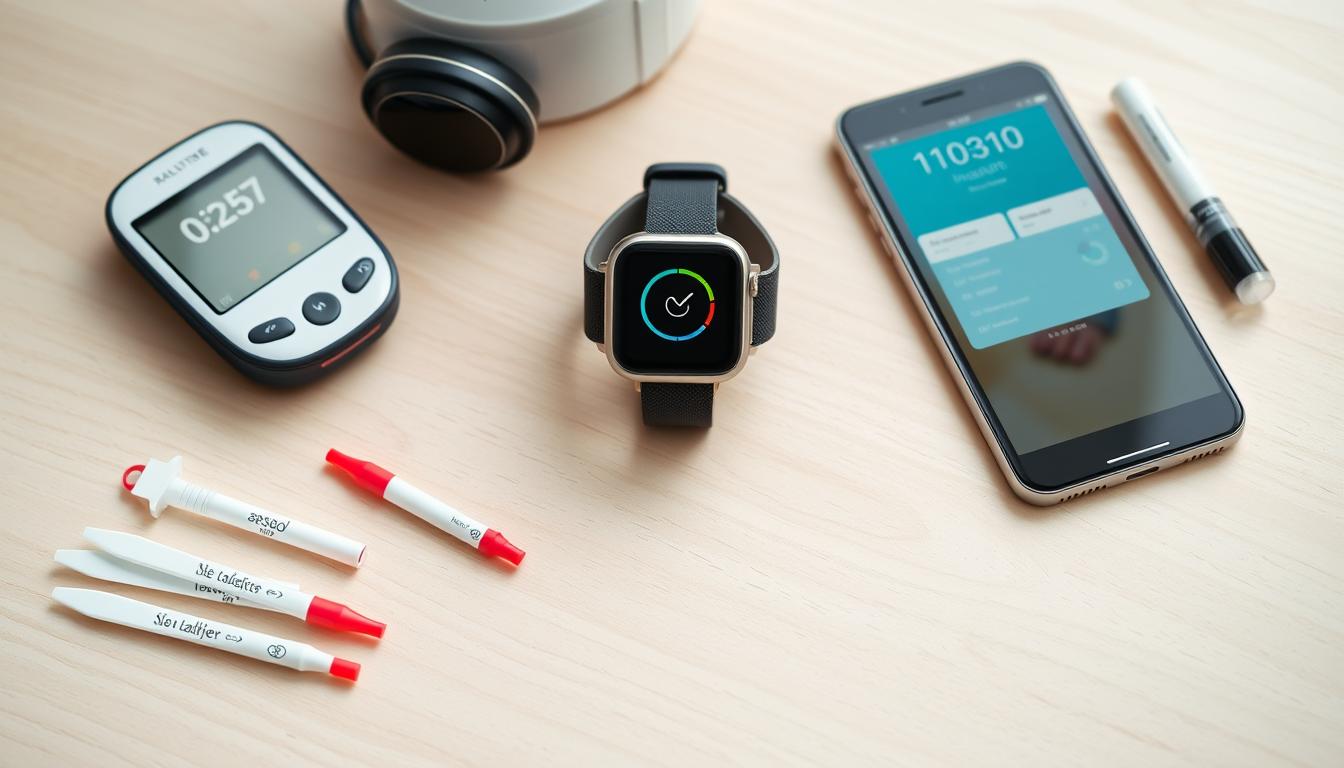Managing diabetes can be tough. But, can new tech really help? The answer is yes, thanks to diabetes management tools.
Many people are using smart devices to control their diabetes better. Millions of people worldwide are finding it easier to manage their condition.
So, what are these devices, and how do they help? This article will look into how smart devices aid in diabetes care. We’ll see their good points and any downsides.
Key Takeaways
- Smart devices can simplify diabetes treatment regimens.
- Diabetes management tools offer improved accuracy and convenience.
- Innovative technologies can enhance quality of life for individuals with diabetes.
- Smart devices can provide real-time monitoring and insights.
- Effective diabetes control is achievable with the right tools.
The Evolution of Diabetes Management
Diabetes management has changed a lot over the years. This change is thanks to new technology and a better understanding of diabetes. We’ve seen big steps forward in how we monitor and treat the condition.
From Urine Testing to Digital Solutions
The path to managing diabetes has been long and full of changes. At first, people used urine tests to check their blood sugar.
Historical Methods of Glucose Monitoring
Old methods for managing diabetes were hard and not very accurate. Urine testing was a main way to check blood sugar. But it had big problems with accuracy and how fast it worked.
The Digital Revolution in Diabetes Care
New technology has changed diabetes care a lot. Continuous Glucose Monitoring (CGM) systems are now common. They give real-time data, helping people make better choices about their diabetes.
The Need for Better Monitoring Tools
Even with new tech, we need better and easier-to-use tools. The main challenges are:
- Improving accuracy and making glucose monitoring less painful
- Getting better at analyzing data for smarter decisions
- Making advanced diabetes tools more accessible and affordable

Understanding Modern Diabetes Technology
The world of diabetes care has changed a lot with new smart devices and digital tools. Now, you have many options to help manage your diabetes better.
Types of Smart Devices Available Today
There are many smart devices to help with diabetes care. These include:
- Glucose monitors that give you real-time data
- Insulin delivery systems you can control from afar
- Wearables that track your health
- Mobile apps to log your glucose, meds, and food
Glucose Monitors and Insulin Delivery Systems
Glucose monitors have gotten better, with continuous glucose monitoring that’s not too uncomfortable. Smart insulin pens make sure you get the right insulin dose at the right time.
Wearables and Mobile Applications
Wearable health devices track your activity, heart rate, and more. They give you a full picture of your health. Mobile apps work with these devices. They let you track your glucose, meds, and what you eat.

How Technology Addresses Key Diabetes Challenges
Technology helps with diabetes by giving you real-time data and better insulin doses. It also makes managing your diabetes easier with digital tools.
| Technology | Benefit |
|---|---|
| Continuous Glucose Monitors | Real-time glucose data |
| Smart Insulin Pens | Accurate insulin dosing |
| Mobile Applications | Comprehensive health tracking |
Using these technologies can help you control your glucose better. It can also make your life with diabetes better.
Continuous Glucose Monitoring Systems (CGM)
Continuous Glucose Monitoring Systems (CGM) have changed how we manage diabetes every day. They give a detailed look at glucose levels all day and night. This helps in managing diabetes more accurately.
How CGM Technology Works
CGM systems use a small sensor under the skin to measure glucose in the fluid around cells. This info goes to a receiver or a phone app, letting users see their glucose levels live.
The sensor must be changed every 7 to 14 days, depending on the system. The data helps spot trends and patterns. This information helps users and doctors make better diabetes plans.
Leading CGM Systems on the Market
There are many CGM systems, each with special features. Some top ones are:
- Dexcom G6 and G7: Known for their accuracy and ease of use, these systems offer real-time glucose data and alerts for high or low glucose levels.
- FreeStyle Libre Systems: These systems are popular for their factory-calibrated sensors, eliminating the need for fingerstick calibrations.
- Medtronic Guardian Sensors: Integrated with Medtronic’s insulin pumps, these sensors offer predictive alerts and can be used to make informed treatment decisions.
Dexcom G6 and G7
The Dexcom G6 and G7 systems are famous for their accuracy and design. They give real-time glucose readings and alert for low or high blood sugar. The Dexcom G7 is the newest, with better performance and a smaller design.
FreeStyle Libre Systems
The FreeStyle Libre systems are easy to use and have sensors that don’t need calibration. Users get glucose readings by scanning the sensor with a reader or phone. The FreeStyle Libre 2 and 3 have extra features like optional alarms for blood sugar levels.
Medtronic Guardian Sensors
Medtronic’s Guardian Sensors work with their insulin pumps for a full diabetes management solution. They give predictive alerts and help make treatment decisions based on data.
Benefits of Real-Time Glucose Data
CGM systems give real-time glucose data, which greatly improves diabetes care. It helps users:
- Spot trends and patterns in glucose levels.
- Make smart choices about diet, exercise, and medicine.
- Lower the risk of low or high blood sugar.
- Improve glucose control and life quality.
By using CGM data, people with diabetes can manage their care better. This leads to better health and quality of life.
Smart Insulin Pens and Automated Delivery Systems
Smart insulin pens and automated systems are changing how we manage diabetes. These tools make taking insulin more precise, easy, and based on data.
Features of Connected Insulin Pens
Connected insulin pens, like the Novo Nordisk NovoPen6 and Echo Plus, have cool features. They track insulin doses, giving important info to patients and doctors.
Novo Nordisk NovoPen6 and Echo Plus
The NovoPen6 and Echo Plus stand out among smart pens. They track doses, send reminders, and let you share data with doctors or apps. This improves care.
Companion Medical InPen
The Companion Medical InPen is also key. It has dose calculators and memory to help manage insulin therapy better.
Dose Calculators and Memory Functions
Dose calculators and memory are vital in smart pens. They ensure the right insulin dose is given, cutting down on mistakes.
How Smart Algorithms Improve Insulin Dosing
Smart algorithms in these pens use data from glucose monitors to suggest doses. This makes insulin therapy more accurate, helping control blood sugar.
Artificial Pancreas Technology
For those with diabetes, artificial pancreas tech is a big hope. It uses smart tech to control insulin, like a real pancreas would.
Closed-Loop Systems Explained
This tech is called a closed-loop system. It watches glucose levels and adjusts insulin automatically. It has a glucose monitor, an insulin pump, and a smart algorithm.
The glucose monitor checks sugar levels all the time. It sends this info to the algorithm. Then, the algorithm tells the pump how much insulin to give. This keeps blood sugar in check, avoiding too high or too low levels.
Current FDA-Approved Systems
There are many artificial pancreas systems approved by the FDA. They offer choices for people with diabetes.
Medtronic MiniMed 770G and 780G
The Medtronic MiniMed 770G and 780G systems adjust insulin based on glucose data. They make managing diabetes easier and better.
Tandem Control-IQ Technology
Tandem Diabetes Care’s Control-IQ system uses Dexcom data to adjust insulin. It’s another way to help control blood sugar.
Insulet Omnipod 5
The Insulet Omnipod 5 is a new, tubeless system. It uses glucose data to adjust insulin. It’s a big step forward in diabetes care.
| System | CGM Compatibility | Key Features |
|---|---|---|
| Medtronic MiniMed 770G/780G | Medtronic CGM | Advanced hybrid closed-loop, automatic basal insulin adjustment |
| Tandem Control-IQ | Dexcom G6 | Predictive glucose control, automatic insulin adjustment |
| Insulet Omnipod 5 | Dexcom G6 | Tubeless design, automated insulin delivery |
User Experiences and Clinical Outcomes
Studies and user feedback show artificial pancreas tech improves life for diabetics. It lowers HbA1c levels and cuts down on low blood sugar.
As this tech gets better, it’s changing diabetes care. It automates insulin and glucose monitoring. This leads to better blood sugar control and health for diabetics.
Wearable Health Devices for Diabetes
Wearable technology has changed how we manage diabetes. Smartwatches and fitness trackers now offer advanced features. These can greatly help in controlling diabetes.
Smartwatches with Glucose Monitoring Capabilities
Smartwatches have grown beyond just tracking fitness. Some now track glucose levels all day. This is a big help for people with diabetes.
Apple Watch and Diabetes Management
The Apple Watch leads in health monitoring, including for diabetes. Apps for the Apple Watch track glucose, remind you to take meds, and show how activities affect glucose.
Fitbit and other trackers are key in managing diabetes. They track activity, which is vital for controlling blood sugar. Regular exercise lowers blood sugar and boosts insulin sensitivity.
Activity Trackers and Their Impact on Diabetes Management
Activity trackers monitor various exercises. This data is key for diabetes management. It shows how exercise affects blood sugar.
Exercise Monitoring and Glucose Control
Tracking exercise helps understand its impact on blood sugar.
“Regular exercise not only improves glucose control but also enhances overall well-being.”
This knowledge aids in making better choices about diet, exercise, and medication.
As wearable tech advances, it will play an even bigger role in diabetes care. It will offer more advanced tools for monitoring and managing diabetes.
Smartphone Apps for Diabetes Control
Smartphone apps are changing how we manage diabetes. They offer tools to track and control the condition. These apps help improve diabetes care and patient results.
Food and Nutrition Tracking Applications
Apps like MyFitnessPal and Lose It! help track food and carbs. This is key for keeping blood sugar in check.
Carbohydrate Counting Tools
Carb counting is important for diabetes care. Apps like Carb Manager list foods and carbs. This makes it easier to choose healthy meals.
Medication Reminder and Glucose Logging Apps
Staying on track with meds is critical. Apps like Medisafe and Glucose Buddy remind users to take meds and log glucose. This helps users follow their treatment plans.
Data Integration Platforms
Many apps connect with health and fitness platforms. This gives a full view of health.
Apple Health and Google Fit Integration
Apps that link with Apple Health and Google Fit share health data. This includes glucose levels, activity, and more.
The American Diabetes Association says tech can improve diabetes care. It gives more data and tools for managing the condition. This lets people with diabetes play a bigger role in their care, leading to better health.
Are Smart Devices the Future of Diabetes Control?
Diabetes management is changing fast with smart devices and connected health tech. It’s important to look at the evidence for these new tools. We need to see how they help patients.
Clinical Evidence Supporting Technology Adoption
Smart devices in diabetes care have solid clinical backing. Research shows they can improve blood sugar control and lower diabetes risks.
Improvements in HbA1c Levels
CGM systems and smart insulin pens help lower HbA1c levels. This means better blood sugar control over time.
Reduction in Hypoglycemic Events
CGM systems with alerts can cut down on low blood sugar events. These alerts help people act fast to avoid low blood sugar.
| Device Type | Improvement in HbA1c | Reduction in Hypoglycemic Events |
|---|---|---|
| CGM Systems | 0.5-1.0% | Up to 50% |
| Smart Insulin Pens | 0.3-0.8% | Variable, depending on user adherence |
Patient-Reported Outcomes and Quality of Life Improvements
Smart devices also boost patient outcomes and quality of life. They give real-time data and insights. This helps people make better care choices.
Mental Health Benefits of Reduced Diabetes Burden
Less work in diabetes care means better mental health. People feel less stress and anxiety about their condition.
Personalized Diabetes Management Through Technology
Technology is making diabetes care more personal and effective. It uses advanced tools and digital solutions to tailor care to each person’s needs.
Tailoring Solutions to Individual Needs
Personalized diabetes care uses data and tech for custom plans. It looks at lifestyle, glucose patterns, and medication to offer better care.
Machine Learning and Adaptive Algorithms
Machine learning is key in personalized diabetes care. It analyzes glucose data and health metrics to spot patterns and predict glucose levels.
How AI Learns Your Glucose Patterns
AI learns glucose patterns from past data like glucose levels, meal times, and medication. This helps AI understand how different things affect glucose levels.
Predictive Alerts and Prevention Strategies
AI uses pattern analysis to send alerts for glucose issues. These alerts warn of high or low glucose, helping people take action to prevent it.
Technology and personalized care help people with diabetes manage their glucose better. As digital health solutions improve, so will diabetes management.
Remote Patient Monitoring and Telemedicine
Remote patient monitoring and telemedicine are changing how we care for diabetes. Now, you can manage your diabetes better with advanced tech. This tech lets you monitor your health in real-time and talk to doctors online.
How Healthcare Providers Use Patient Data
Healthcare providers use data from remote monitoring to make better care plans for you. This data is key for adjusting treatments and acting quickly when needed.
Cloud-Based Diabetes Management Platforms
Cloud-based platforms are important for diabetes care. They store and analyze your glucose data. This lets doctors see your progress and make informed decisions.
Telehealth Consultations and Virtual Care
Telehealth lets you talk to doctors about your diabetes online. It saves time and ensures you get care without needing to see a doctor in person.
Benefits of Virtual Diabetes Care
Virtual diabetes care has many benefits:
- It makes healthcare more accessible.
- It keeps you engaged with regular monitoring and feedback.
- It improves care by using data to make decisions.
By using remote monitoring and telemedicine, you can manage your diabetes better. This approach not only helps your health but also improves your life quality.
Challenges and Limitations of Diabetes Technology
Technology in diabetes care comes with its own set of challenges. It’s important to know the hurdles when using digital health solutions.
Cost and Insurance Coverage Issues
One big problem is the cost. Advanced devices and software can be pricey. Insurance coverage also varies a lot.
Financial Barriers to Technology Access
Some diabetes tech might not be covered by your insurance. Or, you might have to pay a lot out of pocket. This can make it hard to get access to important devices and apps.
Technology Accessibility and Learning Curves
Another issue is making these technologies accessible. This is a big problem for older adults or those not familiar with technology.
Digital Literacy Among Different Age Groups
Using new devices and apps can be tough. Some people find it hard to learn. This shows the need for easy-to-use designs and good support.
Data Privacy and Security Concerns
There are also worries about data privacy and security. You should know how your health info is kept safe.
Protecting Your Health Information
It’s key to understand how your data is protected. Look for devices and apps that follow health data protection rules and have strong security.
In summary, diabetes technology has many benefits but also challenges. Knowing these can help you make better choices for your care.
Conclusion
Smart devices are changing how we manage diabetes. They include continuous glucose monitoring systems, smart insulin pens, and artificial pancreas technology. These tools are making diabetes control easier and more personal.
Wearable health devices, smartphone apps, and remote monitoring are key. They help make managing diabetes more efficient. This means better care for those with diabetes.
Smart devices are important for diabetes care. They help improve health outcomes. But, there are challenges like cost and data security.
These tools offer real-time glucose data and automated insulin delivery. They give you insights to manage your diabetes better. This is a big step forward.
So, are smart devices the future of diabetes control? The answer is yes. They are already making a big difference today. Using these tools can lead to better health and a better life.


